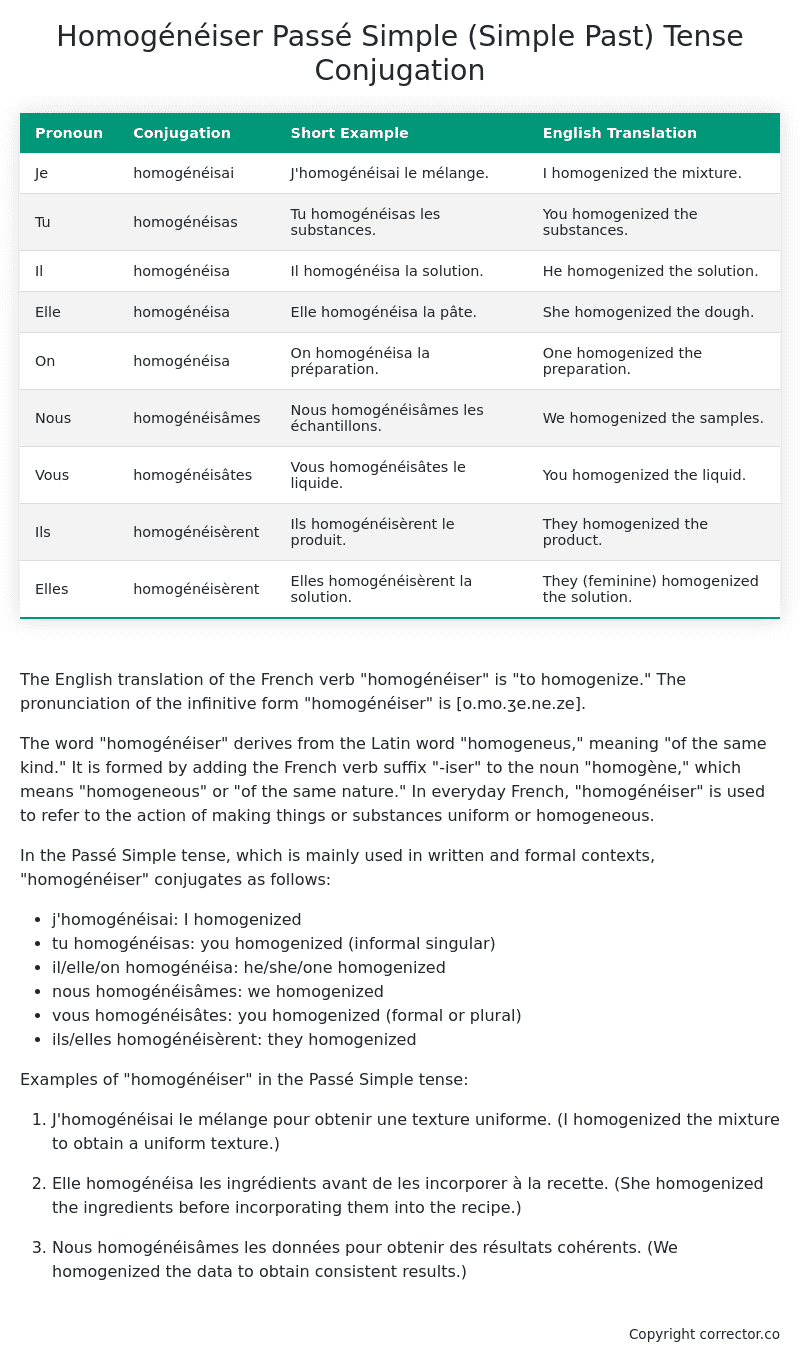Passé Simple (Simple Past) Tense Conjugation of the French Verb homogénéiser
Introduction to the verb homogénéiser
The English translation of the French verb “homogénéiser” is “to homogenize.” The pronunciation of the infinitive form “homogénéiser” is [o.mo.ʒe.ne.ze].
The word “homogénéiser” derives from the Latin word “homogeneus,” meaning “of the same kind.” It is formed by adding the French verb suffix “-iser” to the noun “homogène,” which means “homogeneous” or “of the same nature.” In everyday French, “homogénéiser” is used to refer to the action of making things or substances uniform or homogeneous.
In the Passé Simple tense, which is mainly used in written and formal contexts, “homogénéiser” conjugates as follows:
- j’homogénéisai: I homogenized
- tu homogénéisas: you homogenized (informal singular)
- il/elle/on homogénéisa: he/she/one homogenized
- nous homogénéisâmes: we homogenized
- vous homogénéisâtes: you homogenized (formal or plural)
- ils/elles homogénéisèrent: they homogenized
Examples of “homogénéiser” in the Passé Simple tense:
-
J’homogénéisai le mélange pour obtenir une texture uniforme.
(I homogenized the mixture to obtain a uniform texture.) -
Elle homogénéisa les ingrédients avant de les incorporer à la recette.
(She homogenized the ingredients before incorporating them into the recipe.) -
Nous homogénéisâmes les données pour obtenir des résultats cohérents.
(We homogenized the data to obtain consistent results.)
Table of the Passé Simple (Simple Past) Tense Conjugation of homogénéiser
| Pronoun | Conjugation | Short Example | English Translation |
|---|---|---|---|
| Je | homogénéisai | J’homogénéisai le mélange. | I homogenized the mixture. |
| Tu | homogénéisas | Tu homogénéisas les substances. | You homogenized the substances. |
| Il | homogénéisa | Il homogénéisa la solution. | He homogenized the solution. |
| Elle | homogénéisa | Elle homogénéisa la pâte. | She homogenized the dough. |
| On | homogénéisa | On homogénéisa la préparation. | One homogenized the preparation. |
| Nous | homogénéisâmes | Nous homogénéisâmes les échantillons. | We homogenized the samples. |
| Vous | homogénéisâtes | Vous homogénéisâtes le liquide. | You homogenized the liquid. |
| Ils | homogénéisèrent | Ils homogénéisèrent le produit. | They homogenized the product. |
| Elles | homogénéisèrent | Elles homogénéisèrent la solution. | They (feminine) homogenized the solution. |
Other Conjugations for Homogénéiser.
Le Present (Present Tense) Conjugation of the French Verb homogénéiser
Imparfait (Imperfect) Tense Conjugation of the French Verb homogénéiser
Passé Simple (Simple Past) Tense Conjugation of the French Verb homogénéiser (You’re reading it right now!)
Passé Composé (Present Perfect) Tense Conjugation of the French Verb homogénéiser
Futur Simple (Simple Future) Tense Conjugation of the French Verb homogénéiser
Futur Proche (Near Future) Tense Conjugation of the French Verb homogénéiser
Plus-que-parfait (Pluperfect) Tense Conjugation of the French Verb homogénéiser
Passé Antérieur (Past Anterior) Tense Conjugation of the French Verb homogénéiser
Futur Antérieur (Future Anterior) Tense Conjugation of the French Verb homogénéiser
Subjonctif Présent (Subjunctive Present) Tense Conjugation of the French Verb homogénéiser
Subjonctif Passé (Subjunctive Past) Tense Conjugation of the French Verb homogénéiser
Subjonctif Imparfait (Subjunctive Imperfect) Tense Conjugation of the French Verb homogénéiser
Conditionnel Présent (Conditional Present) Tense Conjugation of the French Verb homogénéiser
Conditionnel Passé (Conditional Past) Tense Conjugation of the French Verb homogénéiser
Conditionnel Passé II (Conditional Past II) Tense Conjugation of the French Verb homogénéiser
L’impératif Présent (Imperative Present) Tense Conjugation of the French Verb homogénéiser
L’impératif Passé (Imperative Past) Tense Conjugation of the French Verb homogénéiser
L’infinitif Présent (Infinitive Present) Tense Conjugation of the French Verb homogénéiser
L’infinitif Passé (Infinitive Past) Tense Conjugation of the French Verb homogénéiser
Le Participe Présent (Present Participle) Tense Conjugation of the French Verb homogénéiser
Le Participe Passé (Past Participle) Tense Conjugation of the French Verb homogénéiser
Struggling with French verbs or the language in general? Why not use our free French Grammar Checker – no registration required!
Get a FREE Download Study Sheet of this Conjugation 🔥
Simply right click the image below, click “save image” and get your free reference for the homogénéiser Passé Simple tense conjugation!

Homogénéiser – About the French Passé Simple (Simple Past) Tense
Formation
Usage
Narration
Historical Context
Interactions with other tenses
Passé Composé
Imparfait
Conditional and Subjunctive
Summary
I hope you enjoyed this article on the verb homogénéiser. Still in a learning mood? Check out another TOTALLY random French verb conjugation!


